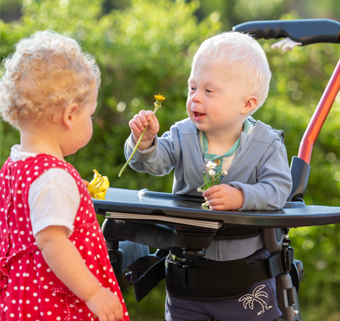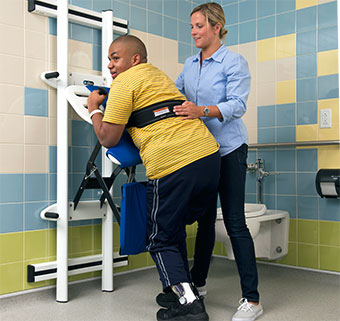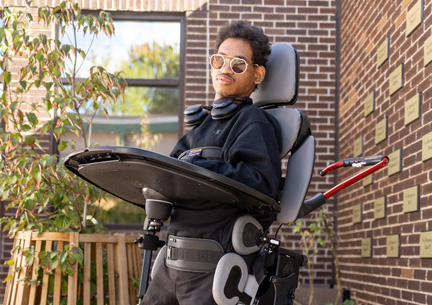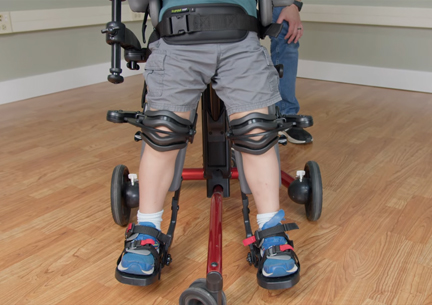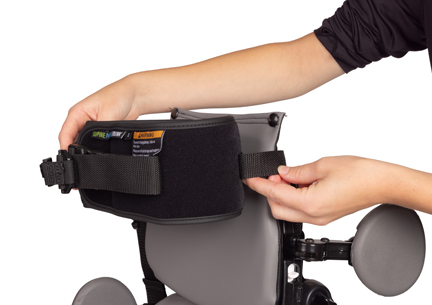Beyond the Stander
A Guide to Encouraging Standing in the Home
| May 2020 Supported standing opens up a world of possibilities for children with disabilities and prepares them for independent mobility. Standing develops weight-bearing ability, teaches trunk and head control and fosters social skills. An adaptive stander provides a secure and controlled setting for standing practice, but there are equally valuable opportunities in everyday tasks. We can teach standing skills during routine sit-to-stand transfers and scheduled toileting breaks. The home is an excellent place to build this important skill. At home, even a table can be a learning prop.
Supported standing opens up a world of possibilities for children with disabilities and prepares them for independent mobility. Standing develops weight-bearing ability, teaches trunk and head control and fosters social skills. An adaptive stander provides a secure and controlled setting for standing practice, but there are equally valuable opportunities in everyday tasks. We can teach standing skills during routine sit-to-stand transfers and scheduled toileting breaks. The home is an excellent place to build this important skill. At home, even a table can be a learning prop.
Creative Standing Opportunities in the Home
Daily standing programs in prescribed equipment are important to maintaining a child’s health, but practice without the stander is just as important for overall standing development. We call this activity-based learning: teaching the skill as part of a child’s day or regular activity. It’s just a matter of expecting the child to participate in the activity instead of having it done for them. With this approach, routine daily activities have great learning potential.
For example, we might transfer a child to the toilet, wheelchair or bed many times in a day. If you can encourage the child to bear some weight through their legs or steady themselves with their hands during the transfer, you open up frequent opportunities for practice.
In the video below, therapists at Lincoln Developmental Center in Michigan share some creative ideas on starting a standing program in the home.
Standing for Toileting

Incorporating standing into the toileting routine might take a shift in thinking. Instead of passively transferring a child onto a changing table for clothing adjustment, try having them stand holding onto something, or if they have minimal weight bearing, leaning their torso forward over a table. Clothing adjustment is certainly easier this way and it is a great starting place to encourage more weight-bearing on a daily basis. Remember, the amount of practice determines how fast and how well a child learns a new skill. A smaller child can learn to lean against his/her caregiver for clothing adjustment or be supported by a seated caregiver’s legs, as pictured. Even if your child is still young and easy to lift, begin activity-based teaching of the standing skill now. As the she grows older and heavier, these skills will become increasingly important.
Talk with your child’s therapist to identify learning potential in your child’s daily routines, and for guidance on how to perform the transfers safely and effectively.
Adaptive Standers: Purposeful Standing
Research suggests that the upright position has numerous overall health benefits, from improving bone mineral density and hip health to encouraging social engagement. A supported standing program can improve skin health, bowel and bladder function, and alleviate contractures. Your child’s therapist can give guidance for using an adaptive stander.
The clinical benefits of a standing program are great, but it’s even better to make the time in the stander purposeful by including them in activities going on around them. When a child moves spontaneously and with purpose they learn faster, build strength and control of their body and advance towards independent standing.
Standing independently requires balance, strength and coordination, so try positioning a child at the kitchen counter to prepare a meal, wash the dishes or stand to play catch with their siblings, even to vacuum the floor. This way the nuances of standing will be introduced naturally. For instance, while they are washing dishes, subtle weight-shifting occurs, the trunk grows stronger and balance improves when a child reaches to place the dishes in the cabinet, catch a ball or vacuum up that crumb in the corner. What’s more, the chance to interact with family or friends at eye-level is invaluable to improving communication and expression.
Stander Overview
Choosing a stander to match the goals and needs of your child is another challenge. There are supine standers, prone standers, mobile standers, sit-to-stand standers and abduction standers. A good stander match will provide quality time in the upright position. Here are some decision making points when considering the available standers.
Supine Stander
 The Supine Stander supports a child from the back. It is usually chosen for the severely involved or medically fragile child because it provides good upper trunk and head positioning and access to life-sustaining accessories such as a tracheotomy. Additionally, when a Supine Stander is in the horizontal position, transferring a large or dependent child from the bed to the stander is easier than with other styles. Children with significant weakness or those bedridden for a long time do well with the Supine Stander because the angle adjustment allows for gradual introduction of weight-bearing and the upright position.
The Supine Stander supports a child from the back. It is usually chosen for the severely involved or medically fragile child because it provides good upper trunk and head positioning and access to life-sustaining accessories such as a tracheotomy. Additionally, when a Supine Stander is in the horizontal position, transferring a large or dependent child from the bed to the stander is easier than with other styles. Children with significant weakness or those bedridden for a long time do well with the Supine Stander because the angle adjustment allows for gradual introduction of weight-bearing and the upright position.
Once in the upright position, try gradually reducing or removing the head support to begin the first stages of teaching and maintaining head control. Remember to engage the child in purposeful activities to get the most out of the standing session.
Prone Stander
 The Prone Stander supports a child at the front. This is a progression from the Supine Stander because the child needs to support their trunk, neck and head against gravity. Gradually lowering the trunk support or adjusting its tilt further challenges these important postural muscles.
The Prone Stander supports a child at the front. This is a progression from the Supine Stander because the child needs to support their trunk, neck and head against gravity. Gradually lowering the trunk support or adjusting its tilt further challenges these important postural muscles.
The prone standing position has other benefits as well. For instance, combining hip abduction options with the firm support at the front of the body is a good solution for maintaining hip health and flexibility. A Prone Stander can also offer a temporary alternative to wheelchair positioning, relieving pressures on the back and buttocks. Adjusting the angle of the stander toward vertical increases weight bearing through the legs. The Prone Stander is also excellent for children with extensor tone because it makes use of the pull of gravity in the opposite direction of the spastic movements.
Mobile Stander
 The Mobile Stander is the final progression in supported standing. Combining standing with movement challenges a child’s balance, weight-shifting ability and postural control. Propulsion and steering require upper body strength spacial awareness, but independent mobility opens up new worlds. With the side wheels in place, a child can explore the home, the outdoors or chat with the neighbors. In a mobile stander, we see increased improvements in upright posturing (which can be further challenged by lowering the trunk board) and improvements in weight-bearing, weight-shifting and balance similar to those experienced with independent standing.
The Mobile Stander is the final progression in supported standing. Combining standing with movement challenges a child’s balance, weight-shifting ability and postural control. Propulsion and steering require upper body strength spacial awareness, but independent mobility opens up new worlds. With the side wheels in place, a child can explore the home, the outdoors or chat with the neighbors. In a mobile stander, we see increased improvements in upright posturing (which can be further challenged by lowering the trunk board) and improvements in weight-bearing, weight-shifting and balance similar to those experienced with independent standing.
Sit-to-Stand Stander
A sit-to-stand stander has the option to alternate between sitting and standing. This especially benefits kids with significant contractures. In this stander, a child may be supported in a partial-standing position as contractures allow. Then, over time, the standing angle may be increased to progress stretch and improve joint motion.
Abduction Stander
An abduction stander might be recommended for the child at significant risk for hip dislocation. These standers provide adequate hip abduction and combined with a 24-hour postural management program, can effectively improve hip stability and alignment.
In the end, providing any opportunities for upright positioning, whether in adaptive standers or through activity-based learning, contributes small advances towards the greater goal of independent standing and walking. Remember to infuse each opportunity to stand with purpose and challenge. Your child has the potential to achieve the impossible!
